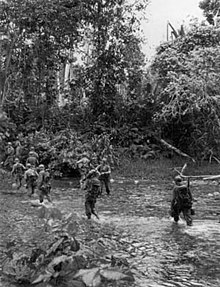32nd Infantry Division (United States)
[citation needed] Orders were received in late December, and the first troops left Waco on 2 January 1918 for the New York Port of Embarkation at Hoboken, New Jersey.
The division's units conducted combat patrols into Germany itself, gaining the distinction of being the first US troops to set foot on enemy soil in World War I.
In the period between the World Wars, the 32nd Division was understrength, with training rarely leaving the local drill hall except for the yearly summer encampment and occasional corps area or army maneuvers.
But on 7 August 1941, by a margin of a single vote, Congress approved an indefinite extension of service for the guard, draftees, and reserve officers, including the Red Arrow Division.
[33][34] : 33 The remainder were housed at Fort Ord near Monterey, California, at the Dog Track Pavilion in Emeryville and at the Cow Palace, where the men slept uncomfortably in stadium chairs and in horse stalls.
[34]: 38 On 22 April 1942, just before the division boarded ships in San Francisco bound for Australia, they received about 3,000 additional soldiers, most of whom had just finished basic training, to fill in their incomplete ranks.
After eight days waiting for transit, the division returned to San Francisco and boarded a convoy of seven Matson Line ships, including the S.S. Lurline and USS Hugh L. Scott at Pier 42.
However, some veterans reported that they received general training with weapons and practice at terrain maneuvers and in jungle warfare, increasing once the unit arrived in Brisbane.
Sergeant Cable was the sole casualty when his Liberty ship, en route from Adelaide to Brisbane, was torpedoed by a Japanese submarine, making him the first soldier of the 32nd Division to die in combat during World War II.
General Willoughby continued to believe that the Japanese only intended to build airfields on the northern coast with the intent to attack Port Moresby and Australia by air.
But the Japanese fought up the northern side of the Owen Stanley Mountains and in the middle of September, after weeks of fighting, descended the southern slopes to Ioribaiwa Ridge, within 32 kilometers (20 mi) of Port Moresby.
Lead elements of the 126th finally crossed the 2,800-meter (9,200 ft) gap near Mount Obree, which they nicknamed Ghost Mountain, where all of the remaining native porters abandoned the Americans, leaving them to carry their own equipment.
On 20 November 1942, after almost 42 days on the trail, crossing exceedingly difficult terrain, including hogback ridges, jungle, and mountainous high-altitude passes, E Company was the first to reach Soputa near the front.
The first day of the assault, Harding was on board a sixty-two-foot wooden coastal trawler, the Australian civilian crewed Minnamurra that was operating as part of the US Army Small Ships Section, with his headquarters company when it and its convoy carrying important artillery and supplies was attacked by Japanese fighter-bombers.
"[54] Harding reluctantly accepted MacArthur's decision to go ahead with the attack and to rely on direct air support in place of tanks or heavy artillery.
The Japanese were now commanded by Maj. Gen. Kensaku Oda, who succeeded General Horii, who had drowned in the Kumusi River[41]: 248 while retreating from their initial attack across the Kokoda Track on Port Moresby.
He received intelligence from Brigadier General Charles Willoughby, who told MacArthur before the operation that there was "little indication of an attempt to make a strong stand against the Allied advance.
Unfamiliar with the state of Japanese defenses, Lieutenant General Richard K. Sutherland, MacArthur's chief of staff, glibly referred to these fortifications as "hasty field entrenchments."
It was unprepared for offensive operations against what turned out to be some of the strongest Japanese fortified positions in the South Pacific, and was severely hampered by completely inadequate fire support.
Eichelberger then ordered a two-day pause in operations, had hot food brought to the front, got additional supplies moved forward, and was able to get the detached 128th restored to the division.
U. S. Air Force historian Stanley Falk wrote, "The Papuan campaign was one of the costliest Allied victories of the Pacific war in terms of casualties per troops committed.
The complete move took several weeks because of the limited number of planes available to transport the troops over the Owen Stanley Mountains and the few ships available to get the men from Port Moresby to Australia.
MacArthur sent Allied forces westward along the 1,500 miles (2,400 km) northern coast of New Guinea in a sequence of operations against selected locations that would provide landing fields for aircraft.
[60][61] Elements of the 32nd's 126th Infantry Regimental Combat Team landed at Saidor on the north coast of New Guinea and helped to end enemy resistance there on 14 April 1944.
In the Battle of Villa Verde Trail, the 32nd navigated a narrow track through the Caraballo Mountains against heavy Japanese resistance and after 100 days of fighting, it took Imugan and the crossroads town of Santa Fe, Nueva Vizcaya.
[64] Four men were awarded the Medal of Honor during its six-week fight up the 27 miles of the Villa Verde Trail: William R. Shockley, David M. Gonzales, Thomas E. Atkins, and Ysmael R. Villegas.
On 6 May 1943, the 32nd Division was awarded the Distinguished Unit Citation, a streamer embroidered Papua, for "outstanding performance of duty in action during the period 23 July 1942 to 23 January 1943."
Ground combat forces, operating over roadless jungle-covered mountains and swamps, demonstrated their courage and resourcefulness in closing with an enemy who took every advantage of the nearly impassable terrain.
In World War I, PFC Joseph William Guyton (1889–1918), became the first American killed on German-held territory, earning him the French Croix de guerre.
Some of these memorials include: The 32nd Red Arrow Division was first formed in July 1917 at Camp McArthur, Waco, Texas of National Guard units from both Wisconsin and Michigan.















